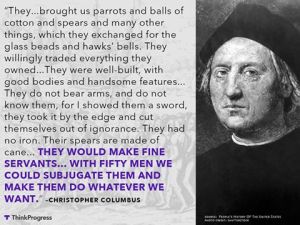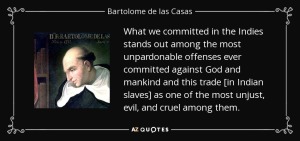“In 1492, Columbus sailed the ocean blue,” was the children’s rhyme used to remember the test question of, “When?”
With Columbus Day less than a month away a better question may be, “Why?” Why do we continue to celebrate the evil that was Christopher Columbus?
When I was in school, the history of Columbus was taught by teachers who didn’t know any more than they were taught when they started school.
Columbus Day, children were told, was created to honor his accomplishment. He discovered America. He set sail with three ships to discover a shorter trade route to Asia. The exploration was funded by Queen Isabella of Spain. When people thought the world was flat, he proved it wasn’t.
While the basic facts of funding, the mission, three ships, and the year of his first voyage are true, the rest is tripe, with the horrible truth about Columbus not revealed. Let’s start with the basics before we delve into the horror.
He wasn’t the “first.” Lief Erikson is now credited with being first European, with solid evidence supporting it.
He didn’t explore for the benefit of discovery. He was seeking riches and power. He would receive 10% of any profit made by Spain from new lands discovered during his journey. He wanted to be made Great Admiral of The Oceans, if he was successful.
He didn’t discover mainland North America. He landed in the Bahamas on October 12, 1492. He never set foot on any land that now comprises the upper 48. The farthest he got, after all 4 journeys, was Cuba.
His shorter trade route to Asia was based on his own incorrect calculations that Asia was within 3000 miles of Spain. It is 9000 miles distant and he never accomplished his original mission, despite 4 journeys.
The calculation of 3000 miles is why he thought he landed east of India and natives were referred to as, “Indians.” In reality, he was lost when he stumbled upon the Caribbean Islands. The natives essentially rescued him, providing him help and provisions as he stepped foot onto the island.
By 1492, seafarers and scholars had no doubt the world was spherical. It had been known for centuries, proved by astronomers and mathematicians. Nobody with an education believed in possibly sailing off the edge of the world.
So, how did Christopher Columbus achieve “Hero” status?
Columbus Day, as we know it in the United States, was invented by the Knights of Columbus, a Catholic fraternal service organization. Back in the 1930s, they were looking for a Catholic hero as a role-model their kids could look up to. In 1934, as a result of lobbying by the Knights of Columbus, Congress and President Franklin Roosevelt signed Columbus Day into law as a federal holiday to honor this “courageous explorer.” Or so, the people and organization involved thought he was.
Historians have brought to light extensive evidence of the damage wreaked by Columbus and his men, leading to an outcry over emphasis placed upon studying and celebrating him in schools and public celebrations.
Just two years ago, a young man, Thomas Weber, a political science and communications major at Bloomsburg University, was a single voice who spoke to the Easton Council. He said the Italian who discovered the New World practiced slavery and was the catalyst for the genocide of Native Americans. Weber’s appearance was reported in the Express-Times.
“Christopher Columbus, while his discoveries were great, his position to Native Americans … represents a figure that I don’t think is someone who should be celebrated by Easton,” said the 19 year-old Weber, who wanted to see the statue honoring Columbus removed from Easton’s Riverside Park.
Weber referred to Columbus as a “dark part of our history.”
“Christopher Columbus was a dark part of our history?” Easton’s Mayor Panto asked. “That’s an opinion,” he told Weber.
Young Mr. Weber responded, “Yeah, that’s an opinion.”
“Tell that opinion to the hundreds of people who mortgaged their homes for that statue,” Panto said. “Maybe to them that’s a different opinion.” Panto went on to say that it cost $13,000 for the statue and Columbus’ accomplishment shouldn’t be downplayed. (Author’s Note: Does Easton still have “hundreds” of people living, who mortgaged their homes in the 1930s? During the Great Depression there were “hundreds” of people who mortgaged their homes to pay for a statue?)
Mr. Panto made a point to disagree with the “opinion” that Columbus was the reason Native Americans were enslaved and tortured.
While Panto may be correct in that Columbus wasn’t directly responsible for what happened to the United States’ Native Americans, the natives of the Bahamas and surrounding islands of Haiti and The Dominican Republic did suffer death, enslavement, torture, and unspeakable cruelty under Columbus’ rule.
Mr. Weber may have erred in his presentation on a couple of points.
First, most associate Native Americans, as those on the North American mainland. He should have made it clear that Columbus’ treatment of indigenous people he encountered on islands in the Americas is not a cause for celebration or hero worship. He should have provided specifics about Columbus’ crimes against humanity.
Second, he conceded to Mr. Panto that it was an “opinion.” While it may be an opinion that Columbus inspired nations to begin the Trans-Atlantic slave trade in the New World and set the tone of treatment toward indigenous people that followed during the United States expansion, Weber should have asserted that what is known about Columbus’ atrocities toward indigenous islanders, as being fact – proof in Columbus’ own logs and those of eye witnesses.
 Columbus noted in his own writings that the gentle Arawaks (the natives of Hispaniola) were remarkable for their hospitality. “They offered to share with anyone and when you ask for something, they never say no,” he wrote. The Arawaks had no weapons; their society had neither criminals, prisons nor prisoners. They were so kind-hearted that Columbus noted in his diary that on the day the Santa Maria was shipwrecked, the Arawaks labored for hours to save his crew and cargo. The native people were so honest that not one thing was missing.
Columbus noted in his own writings that the gentle Arawaks (the natives of Hispaniola) were remarkable for their hospitality. “They offered to share with anyone and when you ask for something, they never say no,” he wrote. The Arawaks had no weapons; their society had neither criminals, prisons nor prisoners. They were so kind-hearted that Columbus noted in his diary that on the day the Santa Maria was shipwrecked, the Arawaks labored for hours to save his crew and cargo. The native people were so honest that not one thing was missing.
Columbus was so impressed with these gentle islanders, that he immediately seized their land for Spain. On his first day he took 6 of them by force, to learn what the island offered in riches. Writing to Spain, he said the natives would make excellent servants due to their gentle nature and that the natives, in unlimited supply, could be sent as slaves to fill any amount ordered.
When informed by Spain that no Christian could be enslaved, the forced baptisms of natives was immediately discontinued. Within months Columbus, in order to justify his inhumane actions that he began, changed his tone about the natives. His initial writings described them as a “handsome” people. He suddenly described them as having “dog-like” noses. They went from a gentle and honest people to claims they participated in cannibalism and drinking human blood. An unfounded claim still taught in some school systems in our country.
Eventually all natives were to be enslaved, either working in his own brutal gold mines, or to be sold as part of his blossoming new venture as a slave trader. Within only two years, 125,000 (half of the population) of the original natives on the island were dead. Within 20 years it was estimated that only 600 original inhabitants may have been living.
The facts are that Christopher Columbus was a murderous and greedy man. A ruthless dictator who lacked a conscience, and would stop at nothing to obtain wealth. His inhumanity extended not only to the natives, but toward colonists he ruled over as Governor of Haiti.
Columbus’ reign of terror is documented by noted historians, former crew members, and even Columbus, himself. Columbus conducted genocide against island natives, became a leader in the slave trade with the new supply of humans placed into forced labor, and sentenced to death or disfigured his own colonists for minor infractions of law.
When one female colonist made a disparaging remark about his origins from low-society that eventually made its way back to him, he had her tongue cut out.
 One of Columbus’ men, Bartolome De Las Casas, was so mortified by Columbus’ brutal atrocities against the native peoples, that he quit working for Columbus and became a Catholic priest. He described how the Spaniards under Columbus’ command cut off the legs of native children who ran from them, to test the sharpness of their blades.
One of Columbus’ men, Bartolome De Las Casas, was so mortified by Columbus’ brutal atrocities against the native peoples, that he quit working for Columbus and became a Catholic priest. He described how the Spaniards under Columbus’ command cut off the legs of native children who ran from them, to test the sharpness of their blades.
On Columbus’ second journey west he brought with him 20 attack dogs, used to track down and dismember slaves who ran, or used a native as prey for a hunt. The dogs wore armor which was more than enough to take down and tear apart natives without fear of losing a valuable dog. Arawak babies were given to dogs for food, according to De Las Casas. Hangings and being burned alive were commonplace.
According to De Las Casas, the men made bets as to who, with one sweep of his sword, could cut a person in half. He says that Columbus’ men threw natives into vats of boiling soap. In a single day, De Las Casas was an eye witness as the Spanish soldiers dismembered, beheaded, or raped 3000 native people. “Such inhumanities and barbarisms were committed in my sight as no age can parallel,” De Las Casas wrote. “My eyes have seen these acts so foreign to human nature that now I tremble as I write.”
Columbus allowed children to be sold to pedophiles. He supervised the selling of native girls into sexual slavery. Young girls of the ages 9 to 10 were the most desired.
In 1500, Columbus casually wrote about his sex slave business in his log. He said: “A hundred castellanoes are as easily obtained for a woman as for a farm, and it is very general and there are plenty of dealers who go about looking for girls; those from nine to ten are now in demand.”
So horrible were the Spaniards that there occurred among the indigenous people mass suicides and mothers mercifully killing their newborn infants, before they met a more horrible death by Columbus’ men as they raided villages. The Conquistadors, under the command of Columbus, were known to take suckling infants from their mother’s breast, to bash them onto large rocks, or feed them to their dogs for amusement.
Columbus’ acts of cruelty were so unspeakable and so legendary – even in his own day – that Governor Francisco De Bobadilla, answering pleas from colonists for help, arrested Columbus and his two brothers, slapped them into chains, and shipped them off to Spain to answer for their crimes against the Arawaks and colonists. But the King and Queen of Spain, their treasury filling up with gold, pardoned Columbus and let them all go free.
Their only stipulation was that their 10% deal on Spain’s profits for Columbus would be nullified and that he and his brothers could no longer be Governor of any island. Their slave industry could continue unabated. King Ferdinand then subsidized Columbus’ 4th voyage back to the islands.
Now, when you drive by Riverside Park in Easton and see that $13,000 statue held in such high regard, you might want to vomit.
Perhaps rededicating it as Leonardo Da Vinci (1452 – 1519) would be better. The statue doesn’t even have to be removed and it would still give praise to an Italian worthy of it. The attire of the statue is even correct for the period. Just put a new plaque on it.
The Knights of Columbus might want to consider a name change, as well. I can see, “Knights of Sister Teresa” as an alternative for a truly good Catholic.
It is no coincidence that a movement has begun seeking to replace Columbus Day with Indigenous Peoples Day, as the truth about Columbus becomes known. Four states have officially adopted it. I suspect, as people are educated about the true Christopher Columbus, more states will follow and eventually the Federal government will stop honoring a psychopath.
Disclaimer: On January 4, 2016, the owner of WestEastonPA.com began serving on the West Easton Council following an election. Postings and all content found on this website are the opinions of Matthew A. Dees and may not necessarily represent the opinion of the governing body for The Borough of West Easton.







